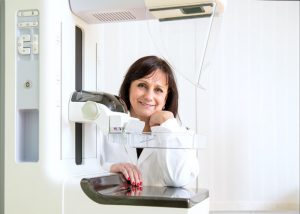For many years, October has been the month of the fight against breast cancer in the Czech Republic. It is not just for nothing. As in the rest of Europe, the number of women newly diagnosed with breast cancer in the Czech Republic increases every year. It is the most common cancer in women - accounting for up to 16 % of all cancer cases in women. MUDr. Miroslava Skovajsová, Ph.D. spoke on this topic on 19 October 2018 on Czech Radio. Here is a recording of the whole interview and a list of some of the questions you will get answers to while listening.

- What do the latest figures from the world and the Czech Republic show?
- How has it changed recently diagnosis of breast diseases?
- What should screening participation look like that physicians would be satisfied with?
- Where's that buried dog, why women don't get screened in greater numbers?
- Is a mammogram absolutely necessary and can a mammogram actually make the situation worse?
- How many women diagnostic mammography was able to save a life?
- When is it appropriate to start a preventive mammogram?
- How reliable are mammograms and ultrasounds?
The full interview, with other equally interesting questions, can be replayed via the player above, or you can also find it in this link.
For breast cancer screening. 62 % of women came, which translated into a 30 % decrease in breast cancer mortality.
An essential part of prevention for young women is self-examination. Despite significant advances in medicine, regular self-examination has not lost its importance. If a young woman combines self-examination and ultrasound examination at least once every 2-3 years as a self-paying woman, there's nothing better he can do for himself.
The mammary gland undergoes the same changes with age as other parts of the body, especially loss of elasticity or flaccidity. That's why we're starting to use mammographywhich can show details even after the breast structure has changed. As we get older, we also look for microcalcifications and non-palpable lesions, where mammography is unsurpassed. If a malignant tumour is found at the minimal non-palpable stage or at the stage of microcalcifications, the woman usually recovers completely. All women in the Czech Republic are entitled to regular mammography from the age of 45, In addition, the Czech screening programme is the only one in the world without an upper age limit.
Sometimes mammography does not provide the ideal amount of information. This is in women whose the remodelling of the mammary gland proceeds more slowly. Since the structure of the breast is still somewhere between the young and the older form, both methods are used. After mammography, which is always the priority, ultrasound is added. However, it should be stressed that ultrasound alone would yield little information, whereas in combination with a mammogram they cannot be overcome.
The screening centres are staffed by radiologists - mammologists who are specialised in breast imaging. The centre system is particularly effective in reducing the number of women dying. It is therefore hard to understand that more than a third of women still do not find their way to preventive screening centres. In the Czech Republic, there are surprisingly large differences in women's access to health. In the Vysočina region, 77 % women have regular mammography every two years. In contrast, only 57 % women in Prague and its surroundings attend. That is, only one in two, while in Vysočina three out of four women know that mammography really helps them. This trend has been going on in the capital for years and it is impossible to get to the bottom of it. The attendance rate in Prague and its surroundings is even lower than the national average of 62 %.
We can only hope that this year's pink month of October has spread important information about quality prevention to women who previously thought they were not affected by breast cancer. In October, they learned, among other things, that most women with the disease come from families where breast cancer has never occurred.

